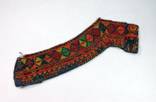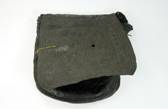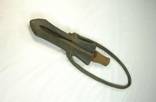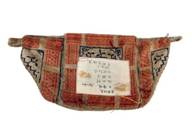|
Tags: aborigine | accessory
The clothing of Taiwan's indigenous people represents the prominent features of each tribe. It symbolizes cultural ideas and beliefs with vivid colors and diverse styles. Every indigenous tribe has its own unique clothing style and characteristics. Creatively, Paiwan, Rukai and Bunun peoples use dark blue or black cloth to present their lively and varied designs. Amis, Tsou, Saisiya, and Atayal peoples are apt to use blood red and azure (sky blue) to express their reverence and love for Nature. And the Yami (Tao) people living on Lanyu Island are the only indigenous tribe to weave cloth using palm fiber. For textile production, all indigenous groups used a squared cloth system. This means they used a horizontal loom with a strap to weave exquisite and beautiful cloth, and then sewed pieces of cloth together to make an integrated garment. A considerable amount of pendants are used by all the indigenous people in Taiwan to make attractive clothing. Shells, buttons, lazurite beads and so forth are added not only for decoration, but also as symbols of status and wealth. The clothing carries a traditional aesthetic meaning. All the colors, patterns and designs signify artistic property and social significance. Trade with the Han had an overwhelming impact on the clothing of Taiwan's indigenous people. The materials and styles have gradually changed. Before the Japanese colonial period, most clothing was made of linen. Later, imported cotton cloth and printed calico were greatly used. Recently, chemical fibers have been replacing the original textile. Clothes that were traditionally separate pieces have changed into light and convenient suits. All these changes have been made to accommodate time and environmental constrictions. However, the clothing of Taiwan's indigenous people has not vanished due to the influences of Han culture and modernization. Thanks to excellent preservation of festivities and customs, traditional clothing can be passed on to the next generation and carry new cultural significance. In certain festivities or ceremonies, indigenous people fully express their ethnic identity by continuing to wear their traditional clothing.
Relevant collections regarding The Clothing of Taiwan's Indigenous People – “Clothing Accessories”:
Former Name: Bullet Bag
- Theme and key word: Tribe: Amis
- Descriptions: Material: Cotton and Fur. Usage: The Alofo Shoulder Bag is used by both the men and women of the Amis to carry things. Somewhat different to the “lover's bag” worn nowadays, records show that this type of shoulder bag was called the Adelats a Lovot (betel nut bag for elders) in Mataian. It was worn by elders over 50 and was woven by their wives. Betel nuts and tools were placed on one side, and tobacco, a pipe and fire igniter on the other. They kept it close to them when working, hunting or fishing. The shoulder bag was the most important thing for every Amis, because the kawas (spiritual power) of the shoulder bag was the strongest among all personal belongings. Traditionally, when an Amis passes away, their personal shoulder bags must be buried with them. Today, the shoulder bag has become a symbol of recognition, and turned into souvenirs due to the development of tourism. An Amis can wear a shoulder bag to represent traditional clothing, and to symbolize `Amis identification.
- Content Description: Alofo Shoulder bag (or Carrying Bag, Lover's Bag, Betel Nut Bag), is a clothing identifier for the `Amis. As long as you are an `Amis, you will have at least one Alofo Shoulder Bag wherever you live. The `Amis Alofo Shoulder Bag is called “`alofo" by NanShi `Amis, “turfot” by Shiouguluan Amis, and “tafuru`” by Atolan Amis. A garment worn daily in the past, the `Alofo Shoulder Bag was one of the most significant accessories for traditional clothing during harvest festivals. In the early periods, the daily shoulder bag was mainly made of linen woven into square shapes. It was plain colored and without patterns, but shoulder bags used for going to festivals were decorated with designs. According to oral description by Huang Gueichao (ibid:75), the kawas (spiritual power) of the shoulder bag is the strongest among all personal belongings. As it was so powerful, it must be buried with the individual upon death. If the deceased individual owned several betel nut bags, the newest ones can be given to others, while the older ones must be buried along with the deceased. The Amis shoulder bag is often called the lover's bag because a match-making event took place on the last night of the harvest festival. During the match-making event, a girl will place a betel nut in the bag of the man she is interested in. If the man feels the same way towards her, he will eat the betel nut, and they will become a couple. This special event gives romantic sense to the shoulder bags. The shoulder bag is also called Betel Nut Bag. In the Amis society, the betel nut bag is a practical piece of clothing. Made by women, they were originally given to children by a mother, or by a female to her lover to confirm their love. Small objects such as pipes, tobacco, betel nut or limes may be placed inside.
- Former Name: Bullet Bag
- Artifact Name: 佩袋
- English Name: Shoulder bag
- Tribal Name: taotao
- Data Identification: Catalog Number: 3340

- Theme and key word: Tribe: Rukai
- English Name: Cloth to wrap corpse
- Tribal Name: IMAI
- Description: Usage: Funeral Burial Ware
- Data Identification: Catalog Number: 3585

- Theme and key word: Tribe: Rukai
- English Name: lapel ornament
- Description: Content Description: Rukai women use bamboo needles or metal embroidery needles with threads to make decorative designs on cloth. Stitches include cross stitch, chain stitch, straight stitch, satin stitch, and ornament stitching.
- Data Identification: Catalog Number: 3588

- Theme and key word: Tribe: Rukai
- Artifact Name: 檳榔袋
- English Name: Betel nut bag
- Tribal Name: LABAZE
- Description: Usage: To carry edible betel nut. Content Description: To carry things, such as betel nut or tobacco. Mostly made out of animal skin in the early days. Some are dyed red with animal blood. They become dark black and tougher after being sun-dried., m
- Data Identification: Catalog Number: 3597

- Theme and key word: Tribe: Tao (Yami)
- English Name: admiration knife
- Tribal Name: savali/takzes
- Description: Usage: Tao (Yami) men wear it when going out for long trips or attending funerals. To wear it, slip the right arm through the rattan ring, and place the knife between the armpit and the side. Content description: When going out on long trips, sailing out at night or attending funerals, Tao (Yami) men carry the admiration knife as a amulet; to protect their own lives and to fend off evil spirits.
- Data Identification: Catalog Number: 3517
|
















